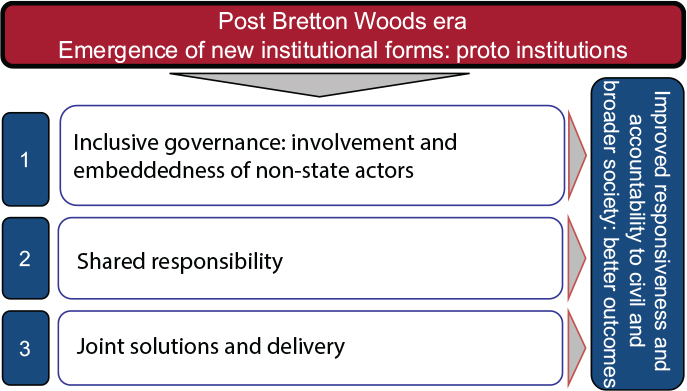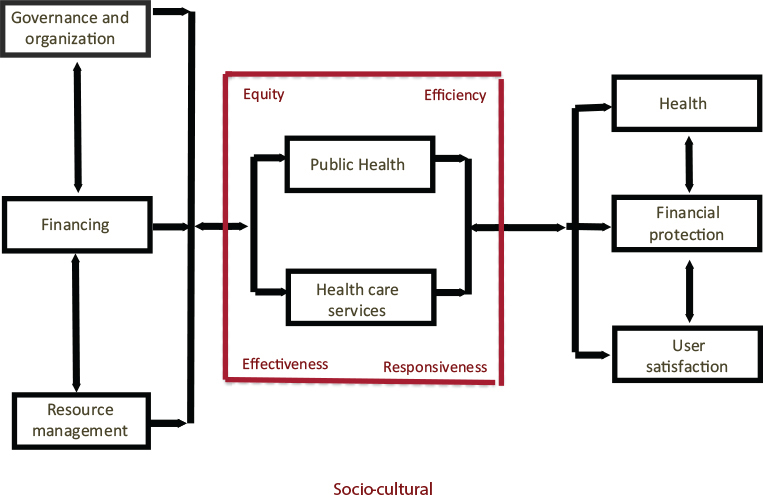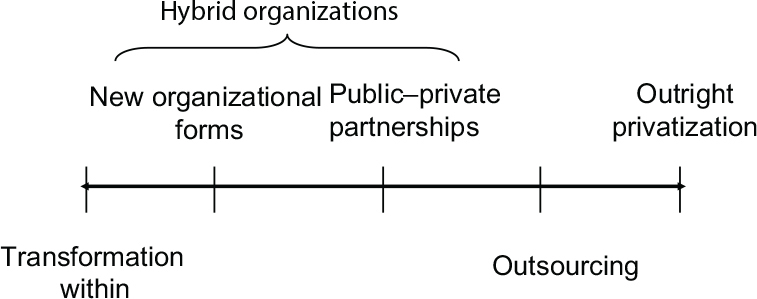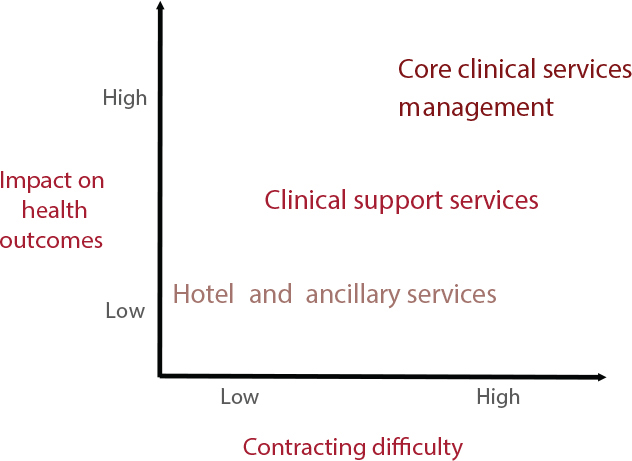2
Setting the Context
In the context of the current global health and development agendas, several workshop speakers emphasized the relevance of health systems strengthening and public–private partnerships (PPPs) to the global Sustainable Development Goals (SDGs). Simon Bland from the Joint United Nations Programme on HIV/AIDS set the context by first describing the predecessor of the SDGs, the Millennium Development Goals (MDGs), which created a global development agenda from 2000 to 2015. Despite some debate over the legacy of the MDGs, Bland suggested that the MDGs created several overarching changes in the global development community. One such change was the establishment of a blueprint for tackling the most pressing global challenges. With the objective of making progress on this articulated blueprint, additional overarching changes followed, including political pressure and momentum, measurement and tracking of progress, resource mobilization, and prioritization and channeling of resources. Since the adoption of the MDGs, governments have been held more closely accountable and official development assistance has increased, with global aid reaching record levels in both 2013 and 2014.
Bland enumerated several measurable outcomes of the MDGs: global poverty was halved 5 years ahead of the MDGs target; 9 out of 10 children are enrolled in primary school, with as many girls as boys in school; remarkable gains have been made in the fights against malaria, tuberculosis, and HIV/AIDS; the likelihood of a child dying before the age of 5 has been nearly cut in half; and the number of people who lack access to
water has been halved. These MDG outcomes, on the whole, have made a profound difference in the lives of many people. However, as Bland noted, the MDGs gave limited attention to the private sector’s role in their advancement or to economic growth and institutional capacity and development.
During the era of the MDGs, the global health agenda and investments expanded and progressed, Bland said. Development assistance focused on health grew from 2000 to 2010 by more than 10 percent. New institutions and partnerships based on PPPs were developed, including the Gavi Alliance; the Global Fund to Fight AIDS, Tuberculosis and Malaria (the Global Fund); and UNITAID, and have mobilized significant resources for specific issues and vertical programs in health. Bland suggested, however, that there is an increasing awareness that verticality and a single-issue approach may not be the most sustainable model going forward.
Moving into the era of the SDGs, which will be defined as 2015 to 2030, Bland emphasized that this new set of goals is not intended to be an updated version of the MDGs, but rather transformational through combining the social, economic, and environmental pillars of sustainable development. Within the health-focused SDG, there are nine targets governing maternal health, child health, communicable diseases, noncommunicable diseases, substance abuse, road traffic safety, sexual and reproductive health services, universal health coverage, hazardous chemicals, and air, water, and soil pollution. These targets span a broad range of issues and conditions, and many indicators will cascade from them.
Considering this expansive range of targets, Bland argued that they will not be achievable without strong health systems. Strong ownership and country leadership are imperative for the robust, resilient, and sustainable health systems that are needed to achieve the ambition of the SDGs. A deep recognition of the determinants of health and related behaviors is also essential to achieve the SDGs, particularly in terms of noncommunicable diseases and injuries. Additionally, Bland believes that multistakeholder approaches, inclusive development, and community engagement are required for success. Without the private sector—and without public, private, and nongovernmental organization (NGO) sectors learning to collaborate evermore closely and effectively—Bland suggested the SDGs will not be realized.
Bland also stressed the importance of ambitious financing focused not only on growth but on efficiencies and reallocation. Currently, the private sector is playing a large role in transforming financing. He suggested that this role needs to be better defined and better understood—as a role that understands the SDGs are good for business and business is good for the SDGs. This includes an improved understanding of and greater
focus on PPPs, where the values are understood and shared; trust is built and sustained; and market failures, gaps, and weaknesses are identified; and where incentives are aligned with the interest of the poor. Achieving the SDGs will require more than financial resources alone, Bland acknowledged. It will require a global change in mindset, approaches, and accountabilities to reflect and transform a new reality of a developing world with highly varied country contexts. He argued that PPPs in the health sphere that are specifically focused on health systems and multisectoral collaboration are an important part of getting the agenda right. The MDGs saw significant progress, but many of the gains are fragile, unfinished, and reversible. Now, there is an opportunity for the SDGs to be smarter, to utilize new technologies, to benefit from connectivity, and to harness grassroots innovations and bidirectional learning. The 2014–2015 Ebola virus disease outbreak in West Africa and the resulting increased attention on global health security created a moment where health systems are more in focus than before.
DEVELOPMENT GOALS AND PUBLIC–PRIVATE PARTNERSHIPS: LESSONS LEARNED FROM THE INFORMATION COMMUNICATIONS TECHNOLOGY SECTOR
Building on Bland’s comments, Reza Jafari from e-Development International shared experiences and lessons learned from the information communications technology (ICT) sector during the implementation of the MDGs to illuminate the importance of PPPs and their relevance for meeting the health-focused targets of the SDGs.
In 2000 when the MDGs were initiated, the Internet was in existence but received little attention within the global community or as part of the development agenda. During the past 15 years, however, both the Internet and the ICT sector have acted as important facilitators to spur progress across the development goals and to bring together vertical sectors in the process. As an example, Jafari highlighted the Broadband Commission for Digital Development, which was established in 2010 at the suggestion of the United Nations, with the intention to boost the importance of broadband on the international policy agenda and to create ecosystems based on a PPP business model that can facilitate and enable cross-sector implementation (e.g., the health, agriculture, education, and manufacturing sectors) of development goals and objectives.
The PPP model employed by the Broadband Commission has evolved to be highly inclusive as a result of the commission’s experiences with facilitating progress on the MDGs. Jafari further defined this PPP model as multilateral, multistakeholder, multilevel partnerships that involve government at the local, state, national, and international levels; the
private sector at the local, regional, and international levels; academia; NGOs; and representatives of the end-user community. When is this PPP model needed? Jafari suggested the intersection of a necessity and an opportunity to make a difference created the space for developing and implementing such a partnership.
Jafari identified the Smart Africa initiative as an example of this inclusive PPP model. Rwandan President Paul Kagame, who is co-chair of the Broadband Commission, developed the idea of Smart Africa, which is using the proven PPP business model to develop a single interface and provide an all-encompassing service to international software product companies that want to conduct business within Africa. Smart Africa is small, agile, and aggressive and provides a platform for practical engagement. For this initiative, multisectoral partners, including ministers from nine countries representing the agriculture, education, finance, health, and ICT sectors, are collaborating to more effectively achieve their individual objectives. For years, each of these partners has faced a lack of resources. The inclusive PPP model of Smart Africa recognizes that, through cooperation and collaboration, there is potential to achieve results more efficiently and at scale.
Experiences in the ICT sector that led to the development of the inclusive PPP model and initiatives such as Smart Africa illuminated several critical success factors for PPPs, which Jafari summarized:
- Focus on the end-user;
- Joint vision and deliverable results;
- Sustainable business model;
- Shared risks and rewards;
- Transformational regulatory environment/framework;
- Transparent and accountable governance;
- Contingency plan for unintended consequences;
- Collaborative innovation; and
- Continuous improvement of processes.
As a result of sharing these success factors from the ICT sector and illuminating the facilitative potential of ICT, Jafari hopes to contribute to the development of successful, inclusive, and multisectoral PPPs within the health sector.
EVOLUTION OF PUBLIC–PRIVATE PARTNERSHIPS AND HEALTH SYSTEMS STRENGTHENING
Rifat Atun from the Harvard T.H. Chan School of Public Health built on Jafari’s comments on the value of PPPs for solving complex problems
and discussed specifically how PPPs are essential within the health sector and for health systems strengthening. Atun proposed two primary reasons why partnerships are critically important in health: (1) health is everyone’s responsibility and thus all sectors have a responsibility to contribute to it, and (2) the current and future problems in health require collective action. Globally, individuals are living longer but with greater disability and morbidity and increased prevalence of multimorbidity; and, as Atun noted, the complexity of these conditions and co-occurrences demands coordinated collective action (IHME, 2010).
Emergence of Proto-Institutions
Since 2000, there has been an emergence of proto-institutions in health at the global level, Atun explained. These proto-institutions are characterized by inclusive governance with the involvement and embeddedness of state actors, shared responsibility, and action for joint-solution development and delivery of these solutions (see Figure 2-1). Prominent examples of these proto-institutions are the Global Fund, the Gavi Alliance, and UNITAID. Atun noted that, together, these three proto-institutions account for 25 percent of the total funding in global health. Other large global health partnerships exist and include the Stop TB Partnership, the Roll Back Malaria Partnership, and the Partnership for Maternal, Neo-

SOURCE: Presented by Rifat Atun on June 25, 2015.
natal & Child Health. There are also many effective smaller partnerships coordinated by organizations such as PATH, the United Nations Foundation, and the International AIDS Vaccine Initiative.
The emergence of these proto-institutions has led to improved responsiveness and accountability to society and, in many cases, better outcomes in shorter timeframes. Atun explained that proto-institutions have not only channeled large amounts of funding to the public sector in host countries but also to non-state actors; and these non-state actors are frequently able to catalyze change on the ground. When he was at the Global Fund, Atun saw non-state actors often acting as catalysts for achieving change and holding a proto-institution’s executive board and secretariat accountable for ensuring that funds were channeled appropriately and results achieved. In his opinion, an important reason these proto-institutions have been successful is the involvement of civil society, affected communities, and other non-state actors. Atun believes these inclusive coalitions, which comprise proto-institutions, the public sector, civil society, and the private sector, are what have characterized global health partnerships of the past decade.
Along with changes to the makeup and structure of global health partnerships, Atun explained that the role of these partnerships has also evolved. In 1993, the primary players were the World Health Organization (WHO), the World Bank, bilateral agencies, and foundations. Today, there is a range of new actors who are playing a role in all the main functions of global collective action. Further, the landscape of global health is very different now than it was in 1993 (Blanchet et al., 2013; World Bank, 1993) (see Table 2-1).
Health Systems Strengthening
In addition to the proto-institutions and inclusive coalitions through which they work, Atun suggested that partnerships are also critically important at the country-level for health systems strengthening. Before discussing the role of partnerships in health systems strengthening, he summarized what health systems are trying to achieve. In a health system, there are a number of functions that, when combined, produce a set of outputs, including public health outputs at the individual and population levels and health care services for individuals or communities (see Figure 2-2). These outputs, in turn, often generate a set of outcomes: improvement of the level and distribution of health, provision of financial protection, and an increase in user satisfaction.
Strengthening health systems, Atun continued, requires working along these functions and outputs to yield the desired outcomes in a balanced way. Specifically, the framework in which partnerships for health
systems strengthening will work is dependent on balancing equity, efficiency, effectiveness, and responsiveness in relation to the outputs of the system to achieve the right outcomes. The appropriate balance will vary depending on the political context in a country at a given the time.
Partnerships for Health Systems Strengthening
Where are the opportunities for partnerships in strengthening health systems? Atun suggested several promising prospects:
- Redefining the role of ministries of health as stewards of the system. Atun suggested that in most countries around the world, there is an evolution of responsibilities of the government. Many countries are redefining the role of ministries of health as the stewards of the system, setting the regulatory framework, the principles, and fair playing field for all actors in the sector—thus, opening the space for private actors in the functions of the health system;
- Structural changes to enhance contestability, use of available assets, and achieve scaled economies;
- Regulatory oversight delegated to quasi-autonomous bodies for functions such as quality and safety; and
- PPPs for financing and service delivery.
There is a continuum of types and functions of PPPs for health systems strengthening, Atun suggested. On one side is public-sector transformation from within, through learning from and applying private-sector principles; on the opposite side is outsourcing and outright privatization; and in the middle are hybrid organizations (see Figure 2-3). An example of a hybrid organization is the autonomous hospital, which is neither public nor private. These new hybrid organizational forms have emerged in many settings, at the primary, secondary, and tertiary care levels. In addition to hybrid organizations, more traditionally structured PPPs have arisen. These PPPs range from private financing initiatives where the private sector provides financing based on a risk-and-reward calculus, to operating the entity that was developed through a joint venture, to managing the whole operation for decades. Like hybrid organizations, these partnerships exist at the primary, secondary, and tertiary care levels, as well as in public health.
Outsourcing and outright privatization of public-sector functions to the private sector is focused on activities that can be better performed by entities whose core business is to provide the particular function; ICT being one such example. Atun noted that many countries are outsourcing
TABLE 2-1 Global Health Organizations and Essential Functions, 1993 and 2013
| Main Functions of Global Collective Action | Function | Sub-function | Substantial Role in the Activity Today? | |||||||||
| Selected Actors (1993) (not exhaustive) | Selected New Actors Since 1993 | |||||||||||
| WHO | World Bank | HIC Bilaterals | Foundations (non-Gates) | MIC Bilaterals | Global Fund | Gavi | UNITAID | Gates | Academics and Think Tanks | |||
| Core | Promotion of global public goods | Research and development | ||||||||||
| Information and databases for shared learning | ||||||||||||
| Comparative evidence and analysis | ||||||||||||
| Harmonizing norms and standards for national use and international regulation | ||||||||||||
| Management of externalities Stewardship | Border control, especially during epidemic outbreaks Convening for consensus building, priority setting, and cross-sector health advocacy | |||||||||||
| Supportive | Act as agent for disposessed, mobilize global solidarity | Provision of basic needs in failed states | ||||||||||
| Assistance in natural or artificial disasters | ||||||||||||
| Protection of vulnerable groups | ||||||||||||
| Support development | International technical cooperation | |||||||||||
| Development financing | ||||||||||||
NOTE: Gates = The Bill & Melinda Gates Foundation; Gavi = Gavi, the Vaccine Alliance; HIC = high-income country; MIC = middle-income country; WHO = World Health Organization.
SOURCES: Blanchet et al., 2013; presented by Rifat Atun on June 25, 2015.

SOURCES: Presented by Rifat Atun on June 25, 2015; WHO, 2015.

SOURCES: Atun, 2007; presented by Rifat Atun on June 25, 2015.

SOURCE: Presented by Rifat Atun on June 25, 2015.
a set of health systems functions. Most countries start with outsourcing services that have limited direct impact on health, such as hotel or ancillary services, and, once they establish some experience, additional services are outsourced, including clinical support services such as the management of a hospital or an entire network of providers (see Figure 2-4).
Within health systems, much time is lost managing operations inefficiently. The WHO estimates that 20 to 40 percent of resources spent on health are wasted. The most common causes of such inefficiency include inappropriate and ineffective use of medicines, medical errors, suboptimal quality of care, waste, corruption, and fraud (WHO, 2010). Collectively, management of human resources productivity, procurement, and supply chain management account for almost 50 percent of the waste, which, if remedied, could be used to create fiscal space to invest in health. Atun noted that there are efficiency gains to be had in managing health systems, and the private sector, through relentless innovation, provides an opportunity to realize these gains, which may be missed when partnerships are not in place.
Beyond clinical support services, Atun suggested there are opportunities to improve efficiencies through PPPs in the areas of information technology and accounting, among others. He provided an example in
which the medical device company Medtronic is managing catheter labs with substantial efficiency gains in several countries and seeing good results in terms of user satisfaction, improved flow of patients, reduced waiting times, and improved consistency in quality of services provided.
To strengthen health systems, effective information systems and managerial capability are needed but often not present, Atun revealed. PPPs are an opportunity to build this capacity. He presented a figure showing where the private sector is actively involved and where PPP opportunities exist (see Figure 2-5). In his opinion, one important area in which to foster the development of PPPs is enabling platforms, specifically the management of information through big data. This includes understanding how data can be captured, but more importantly, how data can be analyzed and then translated to improve real-time management of individual patients as well as the populations. Other areas ripe for PPPs based on private-sector expertise include the management of the supply chain, single-procedure providers, specialty hospitals, disease conditions, intermediaries such as managed care organizations, general hospitals, and primary care or primary care networks or provider networks for an entire district, region, or province. Atun remarked that there are examples of PPPs in each of these areas.

SOURCE: Presented by Rifat Atun on June 25, 2015.
While there are significant opportunities to strengthen health systems through PPPs, Atun acknowledged the lack of evidence to inform decision making. There are numerous examples of effective projects; however, in terms of large-scale interventions, the evidence base is not strongly established. This dearth of evidence is due, in part, to the findings not being published appropriately. Atun strongly urged those involved in PPPs to evaluate achievements and demonstrate successes in relation to improved outcomes and outputs to achieve equity, efficiency, effectiveness, and responsiveness to user needs. Despite the need for more evidence, Atun concluded that, indeed, there are roles for PPPs in health systems strengthening, but the question is how to best do it in differing contexts.
In response to a question about opportunities for PPPs within the national public health infrastructure, Atun stated that the biggest barrier to progress in public health–focused PPPs is the structure of primary care. In most countries, primary care is still being defined and administered based on the 1920 Dawson Report, which sought to distinguish primary care centers as regional centers for health services.1 However, recent advances in technology have enabled countries to change how primary care is administered by moving primary care services outside of the hospital and closer to patients. Further, patients can now take part in managing their health conditions through technology. If a country modifies how primary care is defined and administered, then providing the necessary infrastructure for and investments in primary care or public health will be better integrated. Atun added that payment models are outdated and recommended the creation of new models based on rewarding health outcomes, as opposed to discrete activities focused on components of disease. If the focus is on the individual, with contracts based on the management and outcomes of a population, then the challenges of funding primary care versus public health can be overcome. However, he acknowledged that this transition requires changes in the way health systems have been defined over the past 100 years.
In response to a question about balancing treatment versus prevention, Atun commented that the balance between managing the consequences of disease and managing health is an essential question for health systems, and the transition from disease to health is critical. If the focus is on population-level health and outcomes, then targets can be set to improve or maintain health and rewards developed accordingly.
Patrick Kelley from the Institute of Medicine (IOM) commented that the IOM is exploring potential activities focused on quality of care in
___________________
1 See http://www.jstor.org/stable/20341070?seq=1#page_scan_tab_contents (accessed December 11, 2015).
low- and middle-income countries; however, it has been challenging to identify the priority areas to address as there are many potential avenues to explore within this topic. Kelley asked Atun what he would identify as the priority areas in global quality of care for PPPs. Atun referred again to Figure 2-5 and suggested focusing on developing enablers, such as data systems that demonstrate variance from the standard in quality and safety across multiple conditions. The first investments, he continued, would need to be in developing information sets and datasets to generate baseline knowledge and in identifying and predicting risk for individuals and populations with regard to safety and quality errors. With respect to quality, Atun said the priority areas for investment are understanding determinants of antimicrobial resistance, reducing medication errors, and using supply chain management expertise for administration of guidelines or critical pathways to reduce errors in patient transition.














